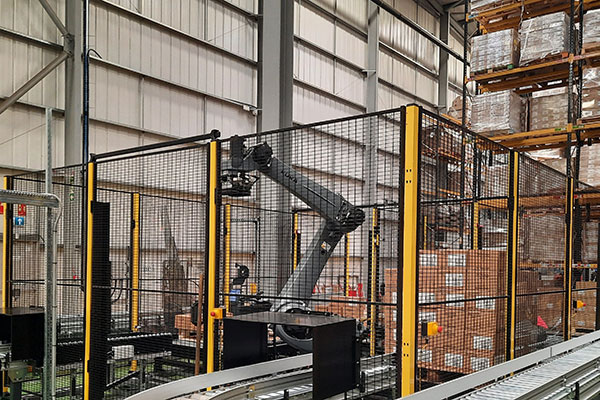The typical payback time on a palletiser system can vary significantly between specific applications. This is due to the fact that calculating payback relates to the comparison between the cost of running your current palletising process, and what savings you will make once the new system is installed, versus the cost of installing and running an automated system. Automated palletising systems will also vary in cost due to the fact that some systems may be very simple such as a single pallet position robotic palletising cell, whereas others will be multi-faceted and have multiple robots palletising off multiple production lines with automatic pallet feeding conveyor systems. As a result, the payback time for each palletising application needs to calculated based on its own merits.
As with any type of capital investment, the shorter the time between when you part with your money, and the capital equipment is up and producing, the quicker the return on investment. This makes it important to include lead time and installation time in your payback calculations, as this can have a significant impact on the payback time. Systems that have a staged payment process throughout the project rather than an upfront payment scheme will enable you to spread the initial capital outlay over a longer period of time, and the time between full capital outlay and payback will be shortened. Also, a palletiser system that can be installed quickly on a short lead time, with minimal disruption to your current production process, will improve your payback period as the time between initial capital expenditure and production throughput will be shortened.
Typically, the payback period of a capital investment is often calculated as Cost of Investment ÷ Average Annual Cash Flow. In this instance, average annual cashflow relates to the savings made each month as a result of the capital investment. ie. If you spend £5,000 to install a capital item, and following install you make savings each month as a result of this investment of £100, it would take 4.2 years to reach the payback period for this investment. However, this is a very basic payback calculation, and doesn’t take into account all of the surrounding dependent factors that will be affected as a result of the capital investment, such as increased OEE, less downtime, greater production throughput, etc. Therefore, when making a significant capital investment, it is better to take more of a holistic view to calculating the return on investment, and include all of the related dependencies and how they will be affected when making your calculations. There are several free downloadable tools available to help you with these more complex payback calculations, and links to some of these are included below:
- Automation Payback Calculator https://www.granta-automation.co.uk/automation-project-payback-calculator
This calculator relates specifically to production/manufacturing environments, and includes all of the key factors you need to included when calculating payback for a palletising system. Along with the standard costs such as labour and maintenance costs, this calculator will also take into account production efficiency improvements, reduction in product defects, increased throughput, increased profits, etc, when calculating the payback time. This gives you a more comprehensive view of what the payback time is likely to be for a palletiser system. - Intangible Benefits Calculator https://www.granta-automation.co.uk/news/how-to-define-the-value-of-intangible-benefits/
This calculator combines many different factors that companies don’t typically look at when investing in capital items, but they do however have a significant impact on payback time. It includes items such admin cost savings, health & safety savings, reduction in repetitive strain injuries and the associated absences they can bring, increased sales, improved selling prices, increased market share; all of which will have an impact on the payback time, but are often overlooked when making payback calculations.
As we have mentioned earlier, the payback time for your specific palletiser application will be unique to your situation, but typically, as a rule of thumb, if you have the equivalent of one person employed full time for palletising, there is payback in less than 2 years.
Palletiser leasing is also another option to consider when calculating payback, as typically with leasing you don’t have to make any initial capital outlay for the project. You will only begin making payments against the project at the same time as you start realising the benefits of having the capital equipment installed. As an example, over the last few palletiser installations we have completed, with a 3 year lease scheme, our customers would make an average production cost saving of £63,063.60 per year after making the lease payments. These savings do not include the value of any production increase, which with a palletiser is typically at least 15%, and more commonly around 40%. They also don’t include any of the other benefits such as; reduced H&S claims, reduced HR, and boosted staff morale. Leasing is an attractive option where there is a good payback case for investing in an automated palletising system, but you don’t have the required capital available to invest.
If you would like any help on calculating the payback period for your specific application then please do get in touch on 01223 499488 or helpline@granta-automation.co.uk and we will be very happy to help.
Find out more…
- Why Are Automated Palletisers Becoming More Financially Viable?
- UK Government Super Deduction Scheme – How Will It Affect My Purchase?
- Can Palletising Be Automated Where The Product Size Changes Frequently?
- Have You Seen This Palletising Video?
- Can You Automatically Palletise Open Top Crates or Boxes?









Warning: Undefined variable $aria_req in /var/www/granta-automation.co.uk/news/wp-content/themes/twentyten/comments.php on line 81
Warning: Undefined variable $aria_req in /var/www/granta-automation.co.uk/news/wp-content/themes/twentyten/comments.php on line 86